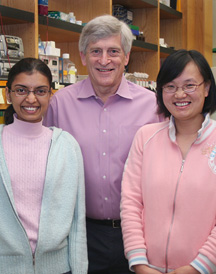

Team Establishes Vastly Improved Technique for Studying Critical Protein Group
By Mark Schrope
Glycoproteins are proteins bound to sugars that are ubiquitous in animal cells, but have proven especially challenging to study, limiting pharmaceutical applications and basic research. But a team of Scripps Research Institute scientists has now developed a technique that offers a 10-fold improvement in the critical process of labeling glycoproteins. This opens the possibility of new studies to identify cancer biomarkers that will allow early cancer diagnoses, among numerous applications.
The work appears as the cover story in the March 2009 issue of the journal Nature Methods.
A huge range of proteins, including many glycoproteins, are found on or secreted from the surface of cells. Glycoproteins in their many forms play a wide range of immune functions and other roles, but limitations in available techniques for working with these biomolecules has slowed progress in understanding them and putting them to use.
"I wouldn't say that protein chemists have been afraid of proteins with sugars, but they have been leery of them because they are more complicated," says James Paulson, from Scripps Research and the paper's senior author. "But almost every cell surface protein is a glycoprotein."
Identifying the structures and roles of glycoproteins, an emerging field known as glycoproteomics, generally begins with attaching tags to the molecules that enable purification and manipulation. Past methods for labeling glycoproteins have been severely hampered by inefficiencies and time-consuming steps that effectively rendered some applications, such as definitive identification of all the glycoproteins found on the surface of a given type of cancer cell, all but impossible.
The team's new method, called periodate oxidation and aniline-catalyzed oxime ligation, or PAL, has proven about 10 times more effective than standard available methods.
Making the Connection
PAL begins with a chemical reaction called periodate oxidation that has been known for decades. The tips of most glycoproteins contain a sugar called sialic acid. Periodate oxidation introduces the highly reactive organic group, aldehyde to sialic acids exposed on the surface of a cell, as well as to glycoproteins in solution. Aldehydes don't normally occur on the cell surface, so the periodate oxidation creates unique reactive sites for exploitation.
Chemical tags will efficiently react with the aldehyde on glycoproteins thus altered, allowing a variety of experimental manipulations. Thanks to previous research by collaborator Philip Dawson, another Scripps Research scientist and co-author of the new study, the team knew that the efficiency of the tagging process, called oxime ligation, is greatly improved when another organic compound called aniline is added to the mix.
"The simplicity is the beauty of it," says Paulson, "And it turns out the chemistry is not at all toxic, so you can do this even to living cells."
For initial experiments, the team labeled glycoproteins with a tag called aminooxy-biotin. Biotin is a frequently employed small molecule tag in biochemical approaches because of its high affinity for a protein called streptavidin. The use of commercially available streptavidin-decorated beads enables the easy enrichment and isolation of biotin-labeled glycoproteins after cells are intentionally lysed, or broken apart. Using PAL, glycoproteins can also be labeled with florescent tags, which are visible in a microscope, allowing researchers to directly observe how glycoproteins behave and interact.
One potential PAL application is in the ongoing hunt for early cancer diagnostics, a primary ambition of glycoproteomics, and cancer research in general. Identifying molecules, especially those found in the blood, that indicate the presence of cancer has proven exceedingly challenging. Such biomarkers could allow early cancer diagnosis long before large tumors or other dangerous signs appear, potentially enabling life-saving therapies. Using PAL, researchers should be able to pull down all the glycoproteins produced by certain types of cancer cells to isolate and characterize them. This would allow identification of those that are unique and might therefore be effective indicators.
Another possible use for PAL is in labeling isolated glycoproteins with different colored fluorescent tags for introduction into embryonic stem cells. This would enable scientists to determine how glycoproteins mediate cell-cell interactions and the roles they play in stem cells' complex development.
"I think there are all kinds of applications," says Paulson of PAL. "It will be up to the imagination of the community."
The first authors of the paper, entitled "High-efficiency labeling of sialylated glycoproteins on living cells," are Ying Zeng and T.N.C. Ramya of Scripps Research. In addition to Paulson and Dawson, authors of the paper include Anouk Dirksen, also from Scripps Research. See http://www.nature.com/nmeth/journal/vaop/ncurrent/abs/nmeth.1305.html.
The National Institutes of Health funded this research.
Send comments to: mikaono[at]scripps.edu

"I think there are all kinds of applications [for the technique]," says Professor James Paulson, shown here with co-authors Ramya Chakravarthy (left) and Ying Zeng. "It will be up to the imagination of the community."

Other authors of the paper, which describes a new method called periodate oxidation and aniline-catalyzed oxime ligation (PAL), include Anouk Dirksen (left), and Philip Dawson.
